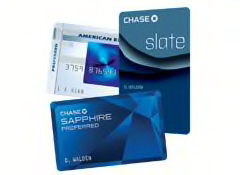Card type
|
APR on purchases
|
Cumulative rewards earned over 12, 24,
and 36 months*
|
Selected features
|
CASH REWARDS CARDS: Good deals for a family spending $400 a month on gas, $600 on groceries, and $1,000 elsewhere.
|
American Express Blue Cash Preferred
|
0% for 12 months, 17.24% to 22.24% after that
|
$770 (12 months)
$1,390 (24 months)
$2,010 (36 months)
|
6% back at supermarkets, 3% back on gas and at department stores, 1% back everywhere else.
$75 annual fee.
No-annual-fee version pays lower rewards.
$150 bonus after spending $1,000 in first 3 months.
|
Fidelity Rewards American Express
|
13.99%
|
$480
$960
$1,440
|
2% back; points can be redeemed for merchandise or cash, or deposited into a Fidelity IRA, 529 college-savings plan, or brokerage account.
|
Capital One
Cash Rewards
|
0% for 12 months, 12.9% to 20.9% after that
|
$460
$820
$1,180
|
$100 sign-up bonus after spending $500 in the first 3 months. 1% back on all purchases; 50% cash bonus at the end of the year, which equates to 1.5% back on all purchases.
No foreign-transaction fee.
|
TRAVEL CARDS: Good deals for a family spending $400 a month on gas, $600 on groceries, and $1,000 elsewhere.
|
Chase Sapphire Preferred
|
15.24%
|
$850
$1,200
$1,560
|
2 points per $1 spent for travel and dining; 1 point per $1 spent elsewhere. 7% bonus on points annually. 40,000 bonus points after you spend $3,000 in first 3 months (equivalent to $500 when redeemed through Chase's travel agent).
$95 annual fee waived the first year. No foreign-transaction fees.
No-annual-fee version pays lower rewards.
|
American Express Blue Sky Preferred
|
0% for 12 months, then 17.24% to 22.24%
|
$760
$1,320
$1,880
|
2 points per $1 spent on dining, hotels, and car rentals; 1 point per $1 spent on flights and elsewhere. 15,000 bonus points (equal to $200) after spending $1,000 within first 3 months.
$75 annual fee.
$100 annual airline allowance for baggage fees, leg-room upgrades, and in-flight purchases.
No-annual-fee version pays lower rewards.
|
Capital One Venture Rewards
|
13.9% to 20.9%
|
$580
$1,000
$1,420
|
2 points per $1 spent; 10,000 bonus points (equal to $100) after spending $1,000 in first
3 months. $59 annual fee waived the first year.
No-annual-fee version pays lower rewards but includes 0% purchase APR for 1 year and 10,000 bonus points.
No foreign-transaction fee for either version.
|
Card type
|
APR on purchases
|
Transfer fees and interest costs over 12/24/36 months** |
Selected features
|
BALANCE-TRANSFER/LOW-RATE CARDS: Good deals for consumers who want to transfer a balance of $10,000.
|
Chase Slate
|
0% on balance transfers and purchases for
15 months, 11.99% to 21.99% after that
|
$0 (12 months)
$910 (24 months)
$2,110 (36 months)
|
The cheapest balance-transfer card, provided you pay off your balance within 15 months. No balance-transfer fee on balances transferred within 60 days of account opening; 3% fee applies on later transfers. |
Citi Diamond
Preferred Card
|
0% for 18 months, then 11.99% to 21.99%
|
$300
$910
$2,110
|
0% on balance transfers for 18 months. 3% balance-transfer fee. |
PenFed Promise Visa***
|
7.49% intro APR for
36 months, switches to prime rate after that (currently 9.99%)
|
$500
$1,000
$1,500
|
4.99% on balance transfers for life makes this the best card if it'll take you more than
2 years to pay off your balance. No balance-transfer fee. |

























